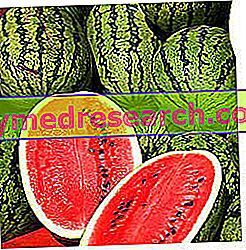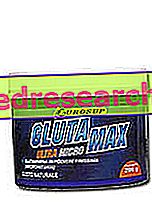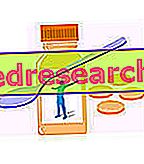Generality
Watermelon means both the edible fruit known as watermelon and the plant that produces it ( Citrullus vulgaris ). Whatever one wishes to call it, the watermelon is a fruit belonging to the VI group of foods; like all the other fruits of this group, it contains good amounts of carotenoids (vit. A), water and mineral salts, while the energy supply is not particularly high.

The watermelon (noun of Latin origin) is a false fruit. Like the pumpkin and the melon, the watermelon is fleshy - peponid (as it has epicarp and fleshy and melocarp mesocarp, while the endocarp is joined to the placenta of the seeds). It has a spherical or oval shape, reaches considerable dimensions and externally is green (shaded in light and dark), while the edible portion (studded with real black or white fruits) shines bright red. The skin of the watermelon is NOT well digested; it is also several centimeters thick (depending on the level of ripeness) and the cut is white or greenish. "Watermelon peel" means the epicarp adhered to a short proximal portion of mesocarp.
The watermelon is a herbaceous, climbing and annual cycle plant. It has large, trilobate and pubescent leaves, while the flowers are small and yellow.
Origins of the watermelon
The watermelon is a plant native to Africa; it grows luxuriant in tropical climates but also in Italy, where it is abundantly cultivated and is available for the whole summer period.
| Nutritional composition per 100g of Watermelon - Reference values of the INRAN Food Composition Tables | ||||||||||||||||||||||||||||||||||||||||||||||||||||||||||||||||||||||||||||||||||||||||||||||||||||||||||||||||||||||||||||||||||||||||||||
 | ||||||||||||||||||||||||||||||||||||||||||||||||||||||||||||||||||||||||||||||||||||||||||||||||||||||||||||||||||||||||||||||||||||||||||||
Nutritional values (per 100 g of edible portion)
| ||||||||||||||||||||||||||||||||||||||||||||||||||||||||||||||||||||||||||||||||||||||||||||||||||||||||||||||||||||||||||||||||||||||||||||
The watermelon is a fruit cultivated since ancient times. While in Europe it was introduced only following the Muslim invasions (and in the East only two centuries earlier), on the African continent it has always been a very important source of water, salt and vitamins. The plant is in fact able to withstand desert climates, therefore arid and hot, and boasts productivity that is anything but negligible. In the areas of origin, the watermelon is considered a real source of sustenance.
Nutritional characteristics
Let's start by pointing out that, as many readers will already know, the watermelon is also known for its "theoretical" aphrodisiac effect. This would be attributable to the content in citrulline (a non-essential amino acid) and to the relative effects of hypercitrullinemia. In reality, this molecule is involved in various functions including immune defense, the urea cycle, etc. In theory, against erectile dysfunction, it should act in different ways: dilating blood vessels and promoting an erection, stimulating the cardiovascular system and elasticizing the blood vessel wall. In practice, it is unlikely that all these functions will reach an intensity of action such as to produce the much desired aphrodisiac effect.
The dietary function of the watermelon is mainly linked to its water content, vitamins and mineral salts. In the hot months of consumption, the watermelon promotes body hydration in a similar way to the water itself; thanks to the osmotic concentration of its fluids, these are easily absorbed, as well as the fructose and potassium dissolved in them. The only warning to take into account in the consumption of the watermelon is NOT to exceed with the portions consumed at the end of a main meal; the considerable water content can in fact prolong, even if only for a short time, the times of gastric permanence (due to excessive dilution of gastric juices).
The watermelon has a fairly limited energy intake and essentially derived from simple sugars (fructose). Protides and lipids are irrelevant and the fiber is not contained in particularly high quantities.
Among the mineral salts there are excellent concentrations of potassium, while the sodium is very low; this characteristic, combined with the excellent concentration of water, makes the watermelon a food suitable for feeding against hypertension. As far as vitamins are concerned, good concentrations of carotenoids (pro vit. A) and vit. C.



